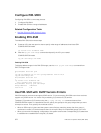3. If a host on the same subnet as another multicast receiver sends an IGMP report for the same
multicast group, the gateway takes no action. If a router between the host and the RP receives a PIM
Join message for which it already has a (*,G) entry, the interface on which the message was received
is added to the outgoing interface list associated with the (*,G) entry, and the message is not (and
does not need to be) forwarded towards the RP.
Refuse Multicast Traffic
A host requesting to leave a multicast group sends an IGMP Leave message to the last-hop DR. If the host
is the only remaining receiver for that group on the subnet, the last-hop DR is responsible for sending a
PIM Prune message up the RPT to prune its branch to the RP.
1. After receiving an IGMP Leave message, the gateway removes the interface on which it is received
from the outgoing interface list of the (*,G) entry. If the (*,G) entry has no remaining outgoing
interfaces, multicast traffic for that group is no longer forwarded to that subnet.
2. If the (*,G) entry has no remaining outgoing interfaces, the last-hop DR sends a PIM Prune message
to towards the RP. All routers along the way remove the interface on which the message was
received from the outgoing interface list of the (*,G) entry. If on any router there is at least one
outgoing interface listed for that (*,G) entry, the Prune message is not forwarded.
Send Multicast Traffic
With PIM-SM, all multicast traffic must initially originate from the RP. A source must unicast traffic to the
RP so that the RP can learn about the source and create an SPT to it. Then the last-hop DR may create an
SPT directly to the source.
1. The source gateway router (first-hop DR) receives the multicast packets and creates an (S,G) entry in
its multicast routing table. The first-hop DR encapsulates the initial multicast packets in PIM Register
packets and unicasts them to the RP.
2. The RP decapsulates the PIM Register packets and forwards them if there are any receivers for that
group. The RP sends a PIM Join message towards the source. All routers between the RP and the
source, including the RP, create an (S,G) entry and list the interface on which the message was
received as an outgoing interface, thus recreating a SPT to the source.
3. After the RP starts receiving multicast traffic via the (S,G), it unicasts a Register-Stop message to the
first-hop DR so that multicast packets are no longer encapsulated in PIM Register packets and
unicast. After receiving the first multicast packet from a particular source, the last-hop DR sends a
PIM Join message to the source to create an SPT to it.
4. There are two paths, then, between the receiver and the source, a direct SPT and an RPT. One router
receives a multicast packet on two interfaces from the same source in this case; this router prunes
the shared tree by sending a PIM Prune message to the RP that tells all routers between the source
and the RP to remove the outgoing interface from the (*,G) entry, and tells the RP to prune its SPT to
the source with a Prune message.
Dell Networking OS Behavior: When the router creates an SPT to the source, there are then two paths
between the receiver and the source, the SPT and the RPT. Until the router can prune itself from the RPT,
the receiver receives duplicate multicast packets which may cause disruption. Therefore, the router must
prune itself from the RPT as soon as possible. Dell Networking OS optimizes the shared to shortest-path
tree switchover latency by copying and forwarding the first (S,G) packet received on the SPT to the PIM
task immediately upon arrival. The arrival of the (S,G) packet confirms for PIM that the SPT is created, and
that it can prune itself from the shared tree.
Important Point to Remember
If you use a Loopback interface with a /32 mask as the RP, you must enable PIM Sparse-mode on the
interface.
PIM Sparse-Mode (PIM-SM)
665


















